read-stricted
A Deep Dive into Banned Books in America

Land of the free, home of the brave. The First Amendment protects our right to speak our mind. But freedom of speech hasn’t eliminated censorship entirely. Books are constantly subjected to challenges and bans, ultimately censoring information. While keeping explicit material from children may make sense, the reasons behind bans don’t always stop at mature content: Racial issues, blasphemous language, violence, and political bias are also common reasons behind bans. After receiving challenges – most often from parents – community leaders must accept or deny potential bans. Currently, banned books include classics like “Of Mice and Men” and worldwide favorites like the Harry Potter series.
To take a deeper look at book censorship and the reasons behind challenges, we tapped into the American Library Association (ALA) and surveyed over 1,000 parents. Despite many people fighting against the censorship of books, 37% of parents believe some books should be completely banned from public schools, likely due to sexually explicit content or nudity. Keep reading to see how the banned book list has evolved over the years and what parents have to say about it.
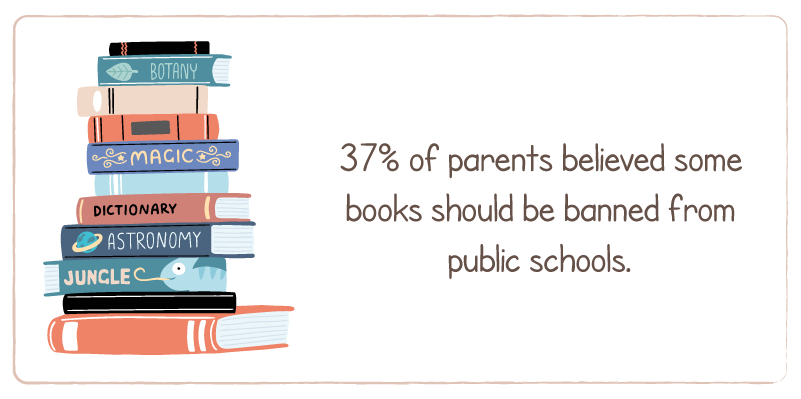
Controversial Content
A single source does not determine the list of banned books – in fact, any individual is allowed to submit a challenge against any media available to the public. By collecting both media reports and reports submitted by individuals, the ALA has maintained a database since 1990. So between 2001 and 2018, which years had the most challenges and bans?

Banned books peaked in 2004, with a total of 547 challenges initiated during this year. Despite a decrease of over 25% the following year, 2006 saw another drastic increase in book challenges with 546. Aside from a peak of 464 in 2012, though, the years between 2010 and 2016 saw the lowest number of challenges.
However, the total number of challenges is only one part of the equation. The specific books challenged can provide a better idea of what the public wants to censor. Interestingly, the Harry Potter series and “The Perks of Being a Wallflower” were the most challenged, experiencing 12 years of challenges each since 2004. While “The Perks of Being a Wallflower” was challenged mainly due to sexually explicit content, the controversy over Harry Potter might be rooted in religious reasoning.
On the Challenged List
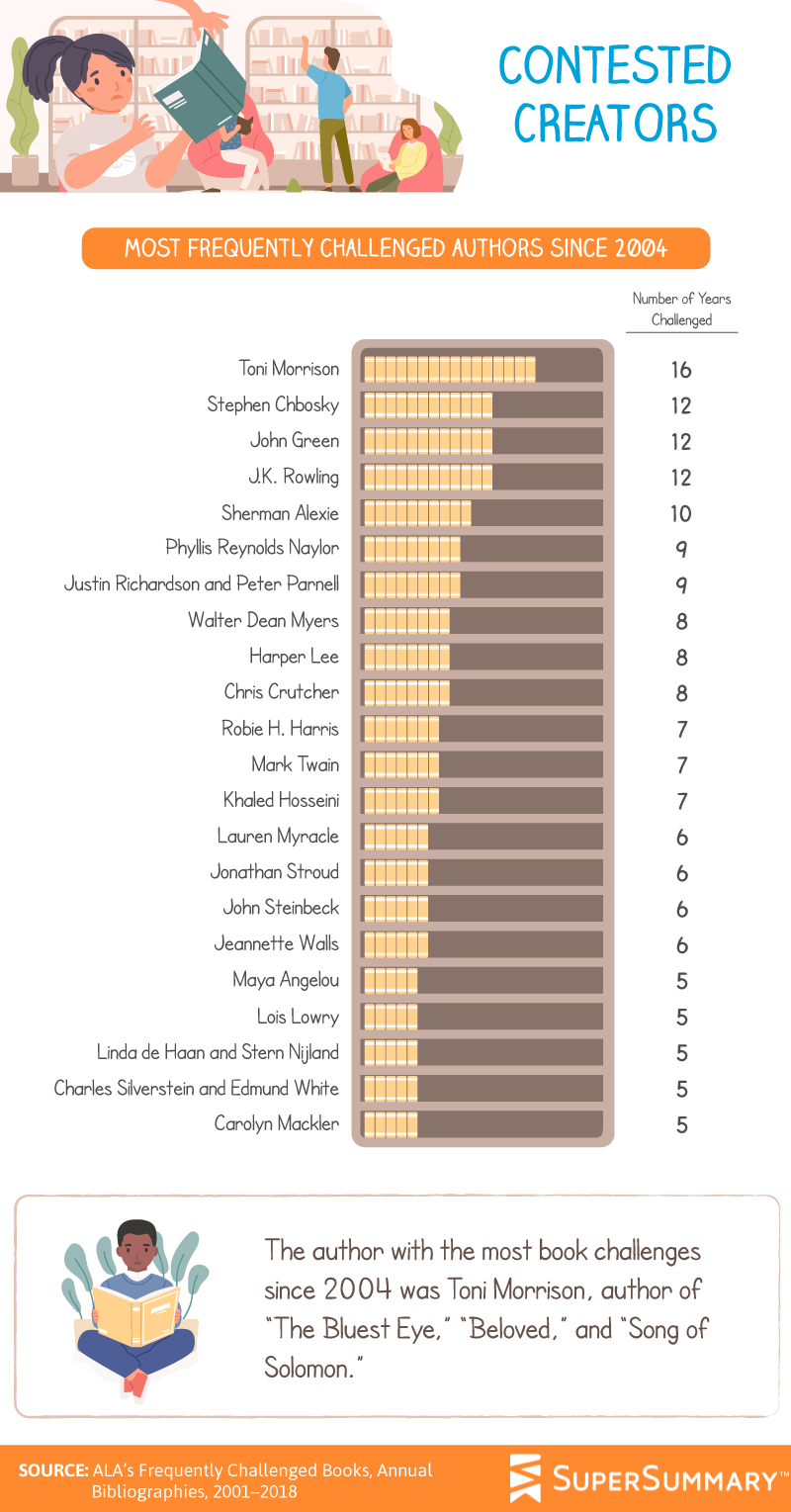
Regardless of the reasons behind book challenges, authors have been very open about their distaste and perplexity toward banned books, but some feel the heat more than others. While authors like Maya Angelou and Lois Lowry have had their fair share of controversy, they had among the least book challenges since 2004. On the other hand, Toni Morrison, author of “The Bluest Eye,” “Beloved,” and “Song of Solomon,” had the most book challenges since 2004 with 16. Stephen Chbosky, John Green, and J.K. Rowling followed, each accumulating 12 challenges since 2004.
To Ban or Not to Ban
Challenges against books typically come from good intentions – protecting children in this day and age is difficult, and parents who perceive books as inappropriate for children may challenge them. However, not all parents feel the same. While 26.3% and 23.9% of parents thought school principals and superintendents, respectively, should have permission to ban books from public schools, 42.6% of parents didn’t think anyone should have that power.
However, political affiliations seems to play a role in book banning – while a third of Independents and 32.2% of Democrats believed some books should be banned from public schools, Republicans were the most likely to believe so, with 46.8% supporting bans.
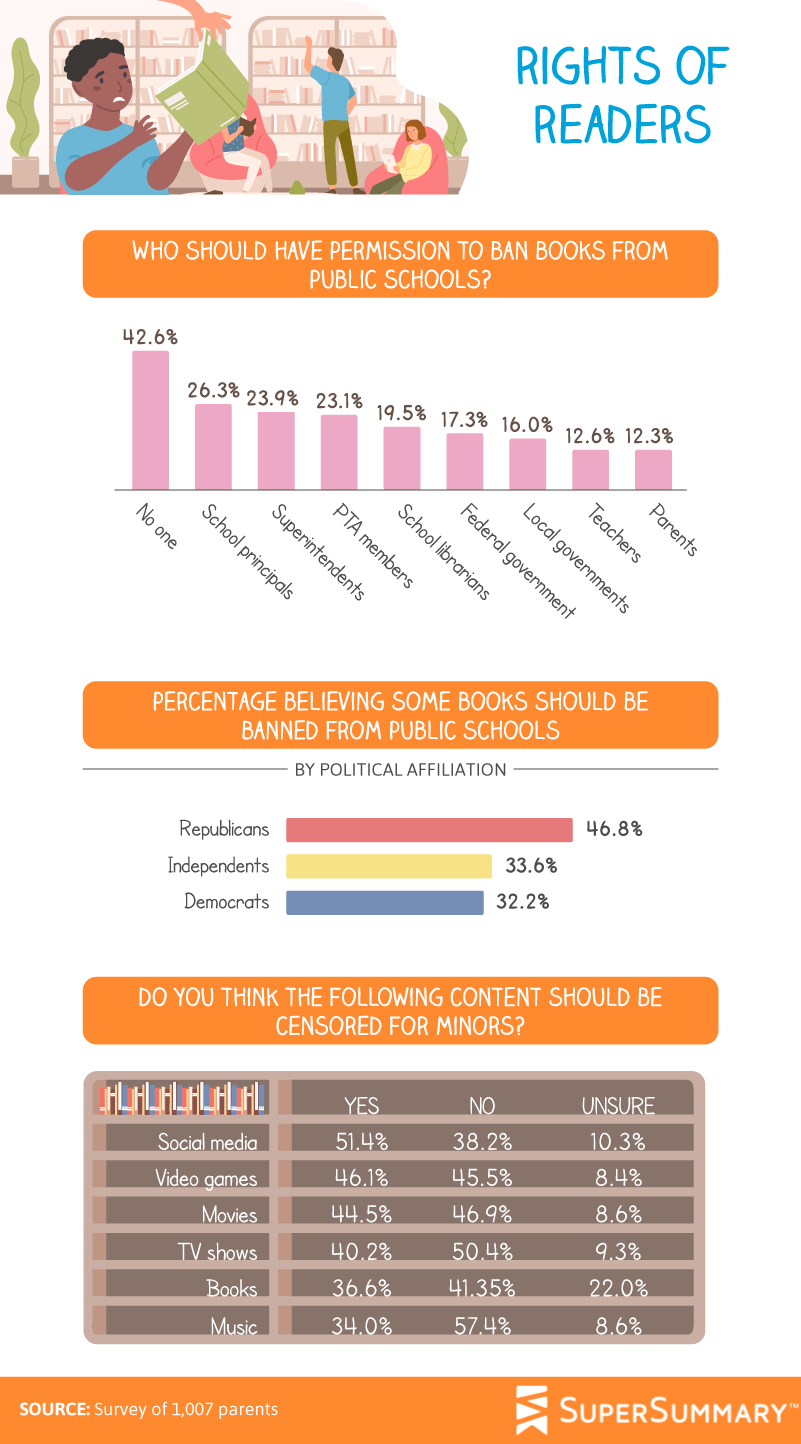 Considering the root of book bans is often to protect minors, do parents carry over this belief to other media? While over half of parents supported censoring social media for minors, 46% and over 44% thought the same about video games and movies, respectively. TV shows and music were less likely to be restricted, with the majority of parents saying censorship wasn’t necessary. And books seemed to fall in the middle. Nearly 37% of parents said book content should be censored for minors, but 22% weren’t sure.
Considering the root of book bans is often to protect minors, do parents carry over this belief to other media? While over half of parents supported censoring social media for minors, 46% and over 44% thought the same about video games and movies, respectively. TV shows and music were less likely to be restricted, with the majority of parents saying censorship wasn’t necessary. And books seemed to fall in the middle. Nearly 37% of parents said book content should be censored for minors, but 22% weren’t sure.
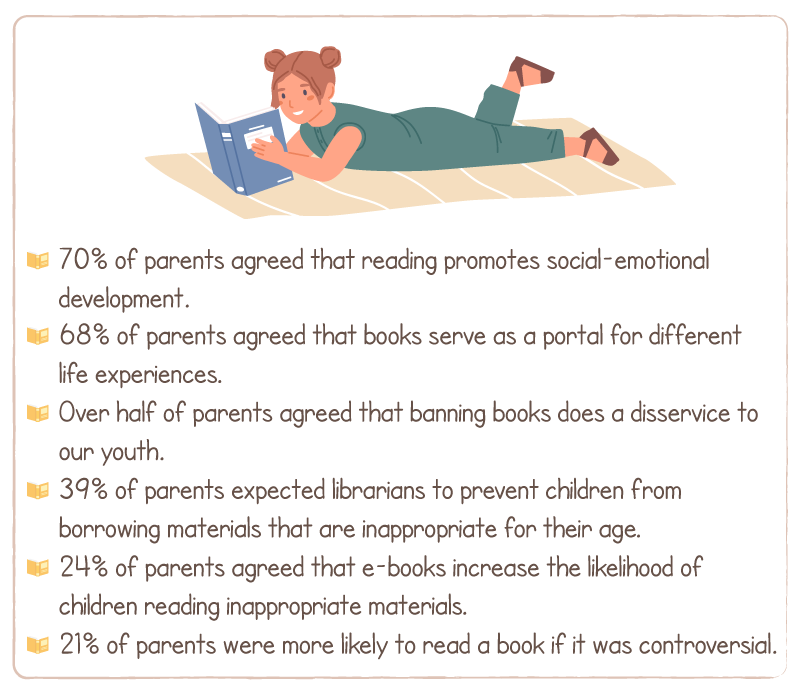
Parents might be more ambivalent in their beliefs about book censorship compared to other media due to the benefits reading provides. While the media often portray video games and TV as a derailment in development, 70% of parents agreed that reading promotes social-emotional development, and 68% said books serve as a portal for different life experiences.
Going Behind the Ban
Once community leaders accept a challenge against a book and pull it from the shelves, the book won’t be available for children to check out at schools or public libraries. However, when it comes to popular books like the Harry Potter series, “The Adventures of Huckleberry Finn,” and even “Captain Underpants,” surveyed parents were pretty supportive of their children reading them.
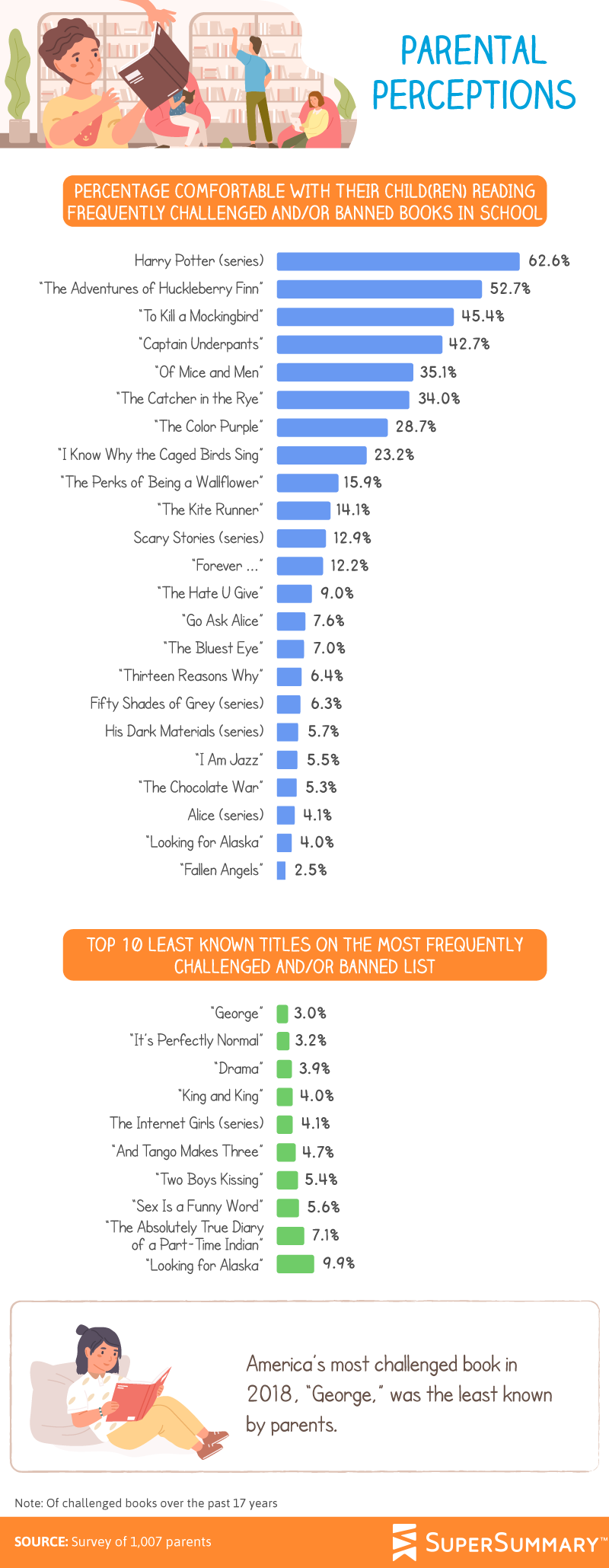
The Harry Potter series was, by far, the most supported banned book, with 62.6% of parents saying they were comfortable with their children reading the novels. Over half of parents were comfortable with their children also reading “The Adventures of Huckleberry Finn,” but John Green’s “Looking for Alaska” and Walter Dean Myers’ “Fallen Angels” were only supported by 4% and 2.5% of parents, respectively.
Despite being one of the most challenged books in 2016 and 2017, Alex Gino’s “George” was the least known among parents. Ironically, the book has won several awards, including the Lambda Literary Award, Stonewall Award, Children’s Choice Debut Author Award, and the gold medal for juvenile fiction in the California Book Awards. Still, language, inappropriate references, and a transgender main character had some parents fighting for its removal from schools and public libraries in Kansas.
For Mature Audiences
TV shows, movies, video games, and even comic books all come with a content rating, which is designed to help parents decide what content is appropriate for their children. While book banning has a similar design, it doesn’t allow parents to make their own decisions and the practice subjects all children to the same level of censorship. In fact, 61.7% of parents believed books should also have a rating system, similar to that of other media.
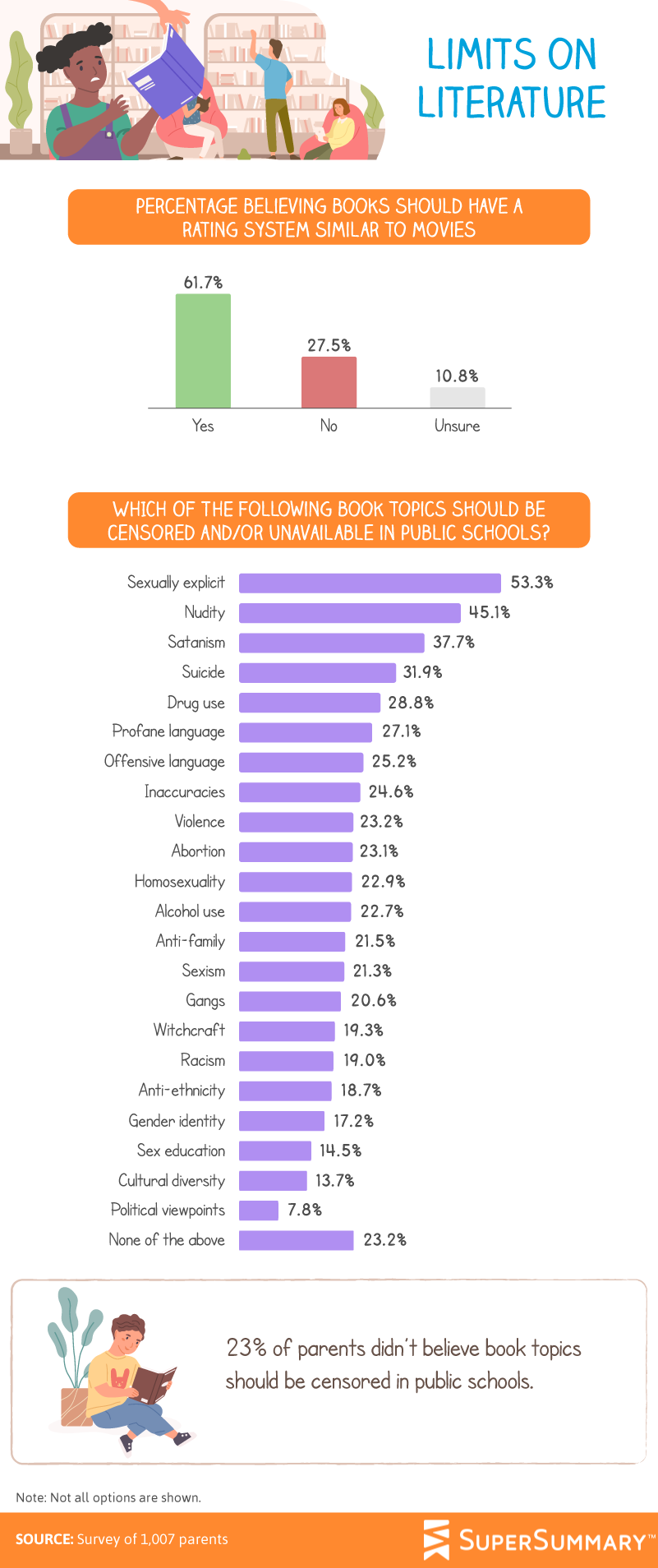
In this case, the most agreed upon content would likely warrant a more mature rating. According to 53.3% of parents, sexually explicit content was the most justifying of censorship, followed by nudity. Satanism, suicide, and drug use were also topics that parents agreed should be censored in books. Nevertheless, 23.2% of parents didn’t believe any book topics should be censored in public schools.
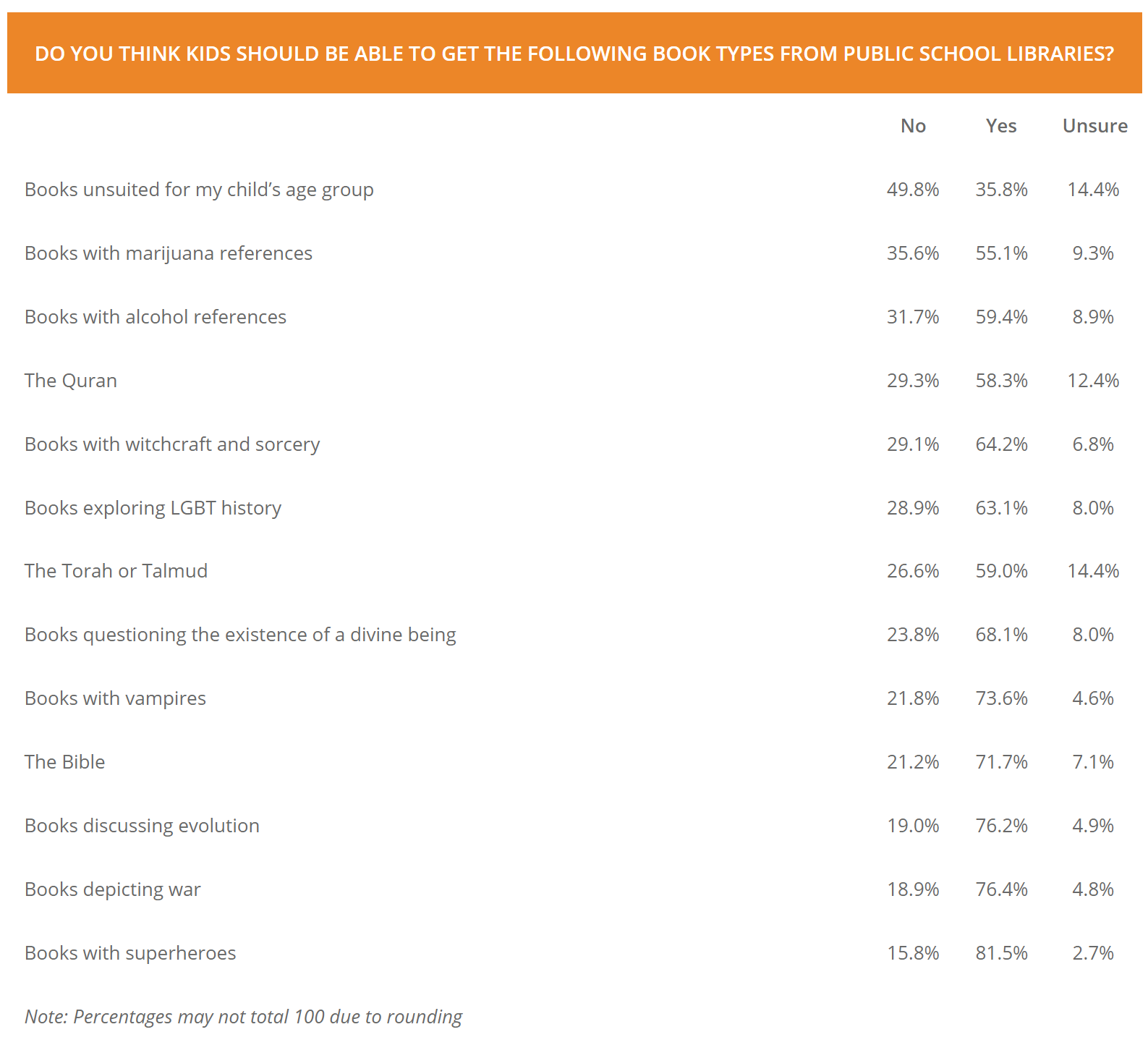
Even when it comes to religion, parents were surprisingly supportive of public school libraries carrying The Bible, The Torah or Talmud, and Quran – while 71.7% of parents thought children should be able to access The Bible, 59% and 58.3% said the same of The Torah and Quran. On the other hand, the majority of parents were concerned about books unsuited for their child’s age group and books that referenced marijuana or alcohol.
Parental Guidance
Whether the reasons behind book challenges are well-intentioned, the notion that any individual can submit a complaint and get a book removed from public libraries raises many questions about censorship in the United States. The First Amendment may protect our freedom of expression, but even books that are widely recognized and even celebrated have been banned from public libraries and schools. Some parents don’t agree with the banning process and would much rather have a rating system in place, but others think books with sexually explicit content or references to drugs and alcohol should remain on the banned list.
Either way, it’s vital for parents to be fully informed of a book’s content before challenging it or supporting its ban altogether. With so many books in a school’s arsenal, it can be difficult for parents to get an in-depth look at the content. Luckily, SuperSummary provides detailed summaries of hundreds of titles, most of which are covered in schools. With in-depth study guides written by experienced teachers, professors, and scholars, parents can quickly and easily get a better idea of what books their children are exposed to. To learn more, visit us online today.
Methodology and Limitations
We tapped into the American Library Association (ALA) to analyze the most frequently challenged or banned books from 2001 to 2018. The ALA’s Office for Intellectual Freedom (OIF) compiles reports from libraries, schools, and the media on efforts made to ban books in communities across the United States. To identify the most challenged or banned books and authors since 2004, our team used findings from the ALA’s annual bibliographies, written by Robert P. Doyle. These bibliographies represent books challenged, restricted, removed, or banned as reported in the “Newsletter on Intellectual Freedom,” “Journal of Intellectual Freedom and Privacy,” and “American Libraries Direct.” The source also includes the total number of challenges recorded by the OIF spanning back to 2001.
To further explore this subject, we surveyed 1,007 American parents via Amazon Mechanical Turk. To qualify for the survey, respondents were required to be parents of a child(ren) currently enrolled in the public education system. Of the 1,007 people included in the study, 547 were female, 457 were male, and three respondents identified as neither male nor female. To ensure respondents took the survey seriously, we employed an attention-check question to identify and disqualify those who failed to read the questions in their entirety. In some cases, questions and answer choices were rephrased for clarity and/or brevity; in all of these instances, an emphasis was placed on accurately representing the respondents’ original intent. The poll had a margin of error of plus or minus 3% with a 95% confidence interval.
This analysis is faced with two primary limitations. One being that the OIF sometimes receives information on challenges as they are happening; other times, they receive online reports a year later. In turn, this affects the total number of challenged books reported in any given year. The most challenged books list shouldn’t be viewed as an exhaustive report. Additionally, not every specific book title was listed in the bibliography reports. The other major limitation is that these data rely on self-reporting. Potential issues associated with self-reporting include but aren’t limited to attribution, exaggeration, and recency bias.
Fair Use Statement
Everyone has an opinion on book banning, but we don’t think your readers should be restricted. The content and graphics from this project are available for noncommercial reuse so that you can share our findings with your friends or followers. Just make sure to link back to this page to give the authors proper credit.